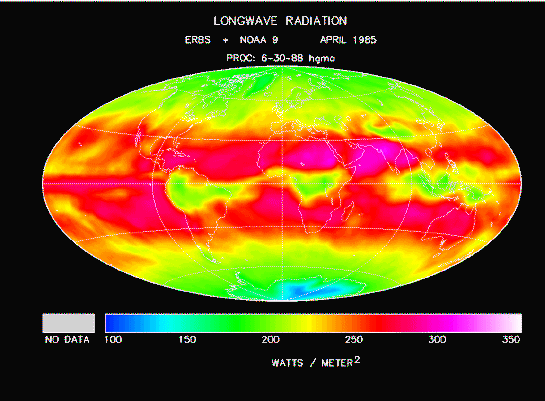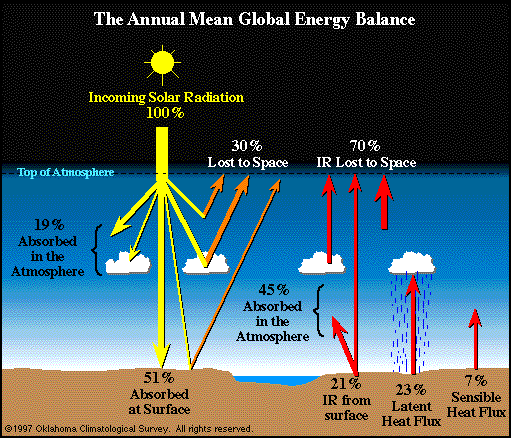- Earth's energy budget
thumb|right|250px|A_schematic_representation_of_the_energy_exchanges_between_the_EarthEarth's atmosphere , andouter space . Note that the total energy entering each level is equal to the energy leaving that level as should be expected for a system in balance.]The
Earth can be considered as a physical system with an energy budget that includes all gains of incoming energy and all losses of outgoing energy. The planet is approximately in equilibrium, so the sum of the gains is approximately equal to the sum of the losses.Note on Accompanying
:These diagrams depict net energy transfer. There is no attempt to depict the role of Greenhouse Gases and the exchange that occurs between the earth's surface and the atmosphere or any other exchanges. These graphics depict only net energy transfer.The Energy Budget
Incoming energy
The total
flux of energy entering the Earth's atmosphere is estimated at 174 petawatt s. This flux consists of:
*solar radiation (99.978%, or nearly 174 petawatts; or about 340 W m-2)
**This is equal to the product of thesolar constant , about 1,366 watts per square metre, and the area of the Earth's disc as seen from the Sun, about 1.28 × 1014 square metres, averaged over the Earth's surface, which is four times larger. The solar flux averaged over just the sunlit half of the earth's surface is about 680 W m-2
**Note that the solar constant varies (by approximately 0.1% over a solar cycle); and is not known absolutely to within better than about one watt per square metre. Hence the geothermal and tidal contributions are less than the uncertainty in the solar power.
*geothermal energy (0.013%, or about 23terawatt s; or about 0.045 W m-2)
**This is produced by stored heat and heat produced by radioactive decay leaking out of the Earth's interior.
*tidal energy (0.002%, or about 3 terawatts; or about 0.0059 W m-2)
**This is produced by the interaction of the Earth's mass with the gravitational fields of other bodies such as the Moon and Sun.
*waste heat fromfossil fuel consumption (about 0.007%, or about 13 terawatts; or about 0.025 W m-2) [http://mustelid.blogspot.com/2005/04/global-warming-is-not-from-waste-heat.html] .There are other minor sources of energy that are usually ignored in these calculations: accretion of interplanetary dust and solar wind, light from distant stars, the thermal radiation of space. Although these are now known to be negligibly small, this was not always obvious:
Joseph Fourier initially thought radiation from deep space was significant when he discussed the earths energy budget in a paper often cited as the first on the greenhouse effect [http://www.wmconnolley.org.uk/sci/fourier_1827/] .Outgoing energy
The average
albedo (reflectivity) of the Earth is about 0.3, which means that 30% of the incident solar energy is reflected back into space, while 70% is absorbed by the Earth andreradiate d asinfrared . The planet's albedo varies from month to month, but 0.3 is the average figure. It also varies very strongly spatially: ice sheets have a high albedo, oceans low. The contributions from geothermal and tidal power sources are so small that they are omitted from the following calculations.So 30% of the incident energy is reflected, consisting of:
*6% reflected from theatmosphere
*20% reflected fromcloud s
*4% reflected from the ground (including land, water and ice)
">
radiation intensity, from clouds, atmosphere and groundThe remaining 70% of the incident energy is absorbed:
*51% absorbed by land and water, then emerging in the following ways:
**23% transferred back into the atmosphere aslatent heat by theevaporation of water, calledlatent heat flux
**7% transferred back into the atmosphere by heated rising air, calledSensible heat flux
**6% radiated directly into space
**15% transferred into the atmosphere by radiation, then reradiated into space
*19% absorbed by the atmosphere and clouds, including:
**16% reradiated back into space
**3% transferred to clouds, from where it is radiated back into spaceWhen the Earth is at thermal equilibrium, the same 70% that is absorbed is reradiated:
*64% by the clouds and atmosphere
*6% by the groundAnthropogenic modification
Emissions of
greenhouse gas es, and other factors such as land-use changes, modify the energy budget slightly but significantly. TheIPCC provides an estimate of this forcing, insofar as it is known [http://www.grida.no/climate/ipcc_tar/wg1/figspm-3.htm] . The largest and best-known are from the well-mixed greenhouse gases (CO2, CH4, halocarbons, etc.), totalling an increase in forcing of 2.4 W m-2 relative to1750 . This is less than 1% of the solar input, but contributes to the observed increase in atmospheric and oceanic temperature.See also
*
World energy resources and consumption
*Orders of magnitude (power) , for comparisons with other quantities of power.
*Greenhouse effect References
* [http://okfirst.ocs.ou.edu/train/meteorology/EnergyBudget2.html "Earth's Energy Budget", Oklahoma Climatological Survey]
* [http://asd-www.larc.nasa.gov/erbe/components2.gif"Earth's Energy Budget" graphic, NASA]
Wikimedia Foundation. 2010.

